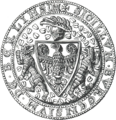Coat of arms of Berlin
| Coat of arms of Berlin | |
|---|---|
 | |
| Versions | |
 Escutcheon-only version | |
| Armiger | City of Berlin |
| Crest | A city coronet Or with five leaves and a gate |
| Shield | Argent a bear rampant Sable langued and armed Gules |
| Use | The state logo may be used by the general public while the coat of arms proper is only eligible for use with authorities. |
The coat of arms of Berlin is used by the German city state as well as the city itself. On top of the shield is a special crown, created by the amalgamation of the mural crown of a city with the so-called people's crown (Volkskrone), used in Germany to denote a republic. Berlin's various boroughs use their own emblems.
The bear was for many centuries only the charge in one out of three fields in the shield, the others displaying the eagles of Brandenburg and Prussia, respectively.
Heraldic beast
This section's tone or style may not reflect the encyclopedic tone used on Wikipedia. (February 2014) |
The usual coat of arms, in use in different styles until the year 1920, showed the Prussian eagle in the first field, the eagle of Brandenburg in the second field and the bear in the third field.[1]
Berlin's citizens, however, wanted their own symbol and coat of arms. How or why they chose the bear remains unknown. Most likely they were thinking of Albrecht I, nicknamed "the bear", who is considered to have been the conqueror and founder of the Margraviate of Brandenburg. Another possibility is that Berliners decided on canting arms since the first syllable of Berlin sounds like "Bär" (bear), although the two are not etymologically related. In medieval times canting arms, arms which displayed a charge correspondent to the name, were a favorite; people tried to depict names by use of phonetically similar symbols or rebuses. The real connection between the name and the charge didn't matter much. The name "Berlin" was created when Slavic tribes settled in the area and is an old Slavic name meaning "place at the swamp" or "in a swampy area".[citation needed] Actually, a pearl may have been a more likely choice for canting arms given that the Middle High German word for pearl is "berle".[citation needed] Middle High German was the language spoken at the time and, indeed, pearls were often used in coats of arms.[citation needed]
History
When more and more cities were being founded in the 12th and 13th centuries, cities wanted official seals to seal official documents such as covenants or orders. Often, the seals incorporated heraldic charges, which soon led to coats of arms being adopted for cities. A seal or coat of arms was usually awarded by the sovereign.
Medieval Berlin and neighbouring Cölln (not to be confused with Cologne) as well as the surrounding cities of the Margraviate of Brandenburg were governed by the Brandenburg Margraves, whose symbol was the red eagle. The oldest preserved and known seal of Berlin is from 1253. It depicts the Brandenburg Eagle spreading its wings in a clover-shaped archway. The text on the seal is SIGILLVM DE BERLIN BVRGENSIVM (seal of Berlin's citizens). It supposedly was the seal of Berlin's first mayor Marsilius.
-
The oldest known Berlin town seal of 1253 copied to the obverse of a Klippe medal by Deutscher Kulturbund, the cultural association of the GDR.
-
Guild Seal of Berlin, 1280 - oldest known official depiction of the Berlin Bear. How the bear originally developed remains unknown.
-
Signet ring of Berlin, 1603
-
The arms of Berlin, 1709
-
Coat of arms of East Berlin, 1954-1990.
-
Coat of arms of West Berlin, 1954-1990.
State logo
To enable civilians and non-governmental institutions to express their affinity with Berlin, the Senate of the Interior and Sports provided a logo which features the arms' shield without the crown in black and white or coloured versions.
Legal status
The coat of arms was laid down in a law of 1954:
§ 1 (1) The coat of arms shows on a silver (white) shield, a black bear rampant with tongue and claws in red. On the shield rests a golden five leaved crest coronet, whose tiara of brickwork is provided with a gate in the center. ... § 4 Decisive for the design of the state's coat of arms, the state’s flag... are the patterns, added to this law. According to the state’s coat of arms, an artistic design is reserved to special purposes.
— Federal Government, Law on the State Symbols of the State of Berlin of 13 May 1954 (GVBl. S. 289) [2]


Symbol of Berlin
The bear has become the symbol of Berlin.[3] Especially the Berlin Buddy Bears: They are all over Berlin, colourful cheerful bears with their arms stretched up high. They have become Berlin's symbol for tolerance and "Weltoffenheit" (world openness). With the Buddy Bears, the centuries-old heraldic animal of Berlin took on a new shape and adopted a new role: The bears are a cheerful welcome for Berliners and their guests as well as ambassadors promoting tolerance and living together in peace all over the world.
See also
- Flag of Berlin
- Berolina, personification of Berlin
- Origin of the coats of arms of German federal states
- Coat of arms of Bern
References
- ^ Senatsverwaltung für Inneres und Sport. "Der Bär im Berliner Wappen - ein geschichtlicher Abriss". Retrieved 2007-10-11.
{{cite web}}: Cite has empty unknown parameter:|coauthors=(help) - ^ Gesetz über die Hoheitszeichen des Landes Berlin
- ^ "Berlin: A Divided City"
External links
![]() Media related to Coats of arms of Berlin at Wikimedia Commons
Media related to Coats of arms of Berlin at Wikimedia Commons






